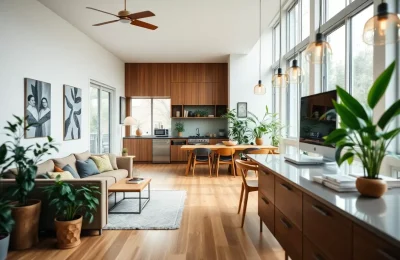
Many homeowners focus on the look of a flooring material, but it’s also important to consider how comfortable it will be underfoot. This is particularly true in rooms where you will be standing for long stretches of time, such as kitchens and utility areas.
Wood flooring, for example, adds warmth to a room and comes in various widths and lengths, plus you can stain it over time.
Hardwood
Hardwood is a durable and beautiful building material that offers a timeless look to any home. It comes in a wide range of colors and grain patterns that complement any design style. Wood floors are also easy to maintain, as they can be refinished when they become worn or discolored.
Choosing hardwood starts with considering your design aesthetic preferences and lifestyle needs. For example, modern homes may prefer sleek and minimal styles, while rustic design calls for distressed or hand-scraped hardwoods that add a timeworn look to the space.
Oak is one of the most popular hardwood choices, as it combines durability with a color palette that works well in any space. Maple is another option that is a good choice for high-traffic areas. Both red and white oak can be stained in a variety of colors, making them versatile flooring options for any home.
Tile
Tile flooring offers a variety of options to suit any design and decorating theme. For example, patterned tiles bring out a bold style, while solid-color choices are versatile and easy to match with other floor surfaces.
Tiles are durable and sturdy. They are less likely to crack or chip compared to other types of flooring materials and can withstand foot traffic, spills, and humidity levels without any damage. In addition, cleaning is fast and simple. Simply sweeping away dust and dirt with a regular vacuum or broom can keep your tiles looking new.
For areas prone to moisture like bathrooms and basements, choose water-resistant tiles to prevent mold and mildew build-up. If you are looking for an elegant and luxurious look, consider choosing porcelain tiles which are denser in composition and stain, scratch, and heat resistant. In addition, opt for large-format porcelain tiles to make your rooms feel bigger and more spacious. Lastly, select heat-resistant and fire-rated tiles for fireplace surrounds.
Vinyl
Vinyl is a popular flooring material because it’s durable, affordable and comes in a wide variety of colors and styles. It’s ideal for high-traffic areas, and can withstand spills and heavy foot traffic with ease.
You can find vinyl options that resemble natural stone and wood, such as white marble, chalky slate, or airy blonde wood. There are also decorative vinyl options that feature stripes, stars, and other fun designs.
Waterproof vinyl is another option that can hold up to heavy foot traffic and household spills. It looks like real tile, but doesn’t feel as cold or hard underfoot. Vinyl’s versatility makes it a popular choice for bathrooms, kitchens and laundry rooms. Many vinyl options are also textured for slip-resistance, and can be embossed to mimic the look of natural materials like stone or hardwood.
Laminate
Laminate is a popular flooring material that’s inexpensive, durable and offers an array of styles. It is also water-resistant, which makes it a great option for areas of the home where spills are inevitable like kitchens and living rooms.
Lighter laminate shades help make rooms appear larger and brighter, while darker tints create warmth and cozy atmospheres. When choosing a laminate color, consider the colors of your walls and furniture. Matching the floor to these colors will ensure a seamless, beautiful look.
Texture is also important in choosing a laminate flooring material. Smooth, high-gloss laminate designs are ideal for modern homes, while textured or hand-scraped laminate can add a rustic and inviting feel. Finally, check the laminate’s AC rating, which will indicate how scratch and stain resistant it is. Laminate can range from AC1 to AC5, with higher ratings providing more durability.










